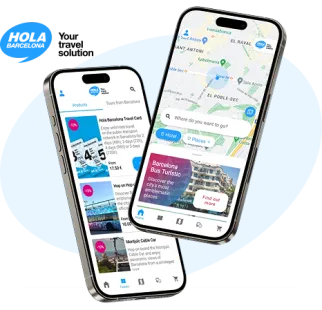El Raval
The former “Chinatown,” where multiculturalism, historical legacy, and modernity now converge
El Raval is one of the most historic neighborhoods in the city: it hosted Barcelona’s first factories, proletarian revolts, and brothels, and today it is home to many of the city’s most modern museums and venues.
The Raval’s tangled alleyways have gone from being a symbol of marginalization to witnessing the birth of a new cultural hub in Barcelona.

Barcelona Bus Turístic, on the Hola Barcelona app
Your app for visiting the city with the Barcelona Bus Turístic: routes, stops and the most iconic places. A comfortable way to carry your tickets too!
The first neighborhood outside the city walls
Today’s Raval, bordered by Pelai Street, La Rambla, Portal de la Pau Square, the Port of Barcelona, Paral·lel Avenue, Sant Pau and Sant Antoni ring roads, and Universitat Square, is a revitalized and multicultural neighborhood. In addition to nightlife venues, it features two of Barcelona’s most modern museums — the CCCB and the MACBA — as well as cultural landmarks like the Gran Teatre del Liceu and the Biblioteca de Catalunya.
The Raval originated in the mid-14th century, when major plagues reduced the city’s population and left open land that was used to build convents and cultivate crops. The neighborhood gained prominence, growing around the Convent del Carme, the Monastery of Nazareth, and the Hospital de Colom. This led King Peter III to order the construction of a new wall to protect the area, which was beginning to urbanize and also housed vulnerable services such as hospitals, orphanages, and leper colonies.
From the 16th century onward, convents along La Rambla multiplied and became the dominant feature of the neighborhood, until the late 18th century, when large factories began to appear — such as the Vapor Bonaplata, the first steam-powered textile factory in Spain, in 1832. This was a time when industrial architecture flourished in the Raval, with house-factories that combined manufacturing and housing in the same space. Many of these buildings are still preserved as part of the neighborhood’s heritage.
The proliferation of factories, the proximity to the port, and the outbreak of the World War contributed to the neighborhood’s decline. A cosmopolitan, rebellious, and marginalized Raval was born, where drugs like cocaine arrived for the first time, and jazz and tango became the soundtrack of cabarets and brothels. It was during this period that authors like Francisco Madrid, Juli Vallmitjana, and Josep Maria de Sagarra dubbed the Raval “Chinatown,” referring to the poverty and marginalization that permeated its streets. Iconic venues from this era included the London Bar, a true cave with live music; Marsella, where absinthe was served; and the bar Pastís.
How to get to the Raval neighborhood?
From the Plaça de Catalunya stop on the Blue Route of the Barcelona Bus Turístic, walk down La Rambla and turn onto Hospital Street to enter the Raval and explore its streets.
For the curious
- Barcelonans have a verb, “ravalejar,” which means to stroll through this neighborhood. It’s the only district with its own verb!
- Don’t forget to walk along the Rambla del Raval — very cosmopolitan and full of terraces.











